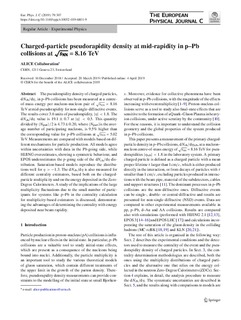Charged-particle pseudorapidity density at mid-rapidity in p–Pb collisions at √sNN = 8.16 TeV
Acharya, Shreyasi; Acosta, Fernando T.; Adamová, Dagmar; Adhya, Souvik Priyam; Adler, Clemens; Adolfsson, Jonatan; Aggarwal, Madan M.; Aglieri Rinella, Gianluca; Agnello, Michelangelo; Ahammed, Zubayer; Alme, Johan; Altenkaemper, Lucas; Djuvsland, Øystein; Ersdal, Magnus Rentsch; Fionda, Fiorella Maria Celeste; Nystrand, Joakim; Rehman, Attiq ur; Røhrich, Dieter; Tambave, Ganesh Jagannath; Ullaland, Kjetil; Wagner, Boris; Yuan, Shiming; Zhou, Zhuo; Arsene, Ionut Cristian; Bätzing, Paul Christoph; Dordic, Olja; Lardeux, Antoine Xavier; Lindal, Svein; Mahmood, Sohail Musa; Malik, Qasim Waheed; Richter, Matthias; Røed, Ketil; Skaali, Toralf Bernhard; Tveter, Trine Spedstad; Wikne, Jon Christopher; Zhao, Chengxin; Helstrup, Håvard; Hetland, Kristin Fanebust; Kileng, Bjarte; Nesbø, Simon Voigt; Storetvedt, Maksim Melnik; Langøy, Rune; Lien, Jørgen; Ahmad, Shafiq F.; Ahn, Sang Un; Aiola, Salvatore; Akindinov, Alexander; Al-Turany, Mohammed; Alam, Sk Noor; De Albuquerque, Danilo Silva; ALICE, Collaboration
Journal article, Peer reviewed
Published version
Permanent lenke
http://hdl.handle.net/11250/2608721Utgivelsesdato
2019Metadata
Vis full innførselSamlinger
- Institutt for mikrosystemer [546]
- Publikasjoner fra CRIStin [3623]
Sammendrag
The pseudorapidity density of charged particles, dNch/dη, in p–Pb collisions has been measured at a centre-of-mass energy per nucleon–nucleon pair of sNN√ = 8.16 TeV at mid-pseudorapidity for non-single-diffractive events. The results cover 3.6 units of pseudorapidity, |η| < 1.8. The dNch/dη value is 19.1±0.7 at |η|<0.5. This quantity divided by ⟨Npart⟩ / 2 is 4.73±0.20, where ⟨Npart⟩is the average number of participating nucleons, is 9.5% higher than the corresponding value for p–Pb collisions at sNN√ = 5.02 TeV. Measurements are compared with models based on different mechanisms for particle production. All models agree within uncertainties with data in the Pb-going side, while HIJING overestimates, showing a symmetric behaviour, and EPOS underestimates the p-going side of the dNch/dη distribution. Saturation-based models reproduce the distributions well for η > −1.3. The dNch/dη is also measured for different centrality estimators, based both on the charged-particle multiplicity and on the energy deposited in the Zero-Degree Calorimeters. A study of the implications of the large multiplicity fluctuations due to the small number of participants for systems like p–Pb in the centrality calculation for multiplicity-based estimators is discussed, demonstrating the advantages of determining the centrality with energy deposited near beam rapidity.
Beskrivelse
Open Access This article is distributed under the terms of the Creative Commons Attribution 4.0 International License which permits unrestricted use, distribution, and reproduction in any medium, provided you give appropriate credit to the original author(s) and the source, provide a link to the Creative Commons license, and indicate if changes were made.

